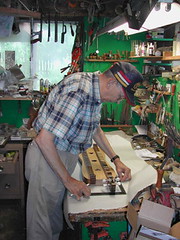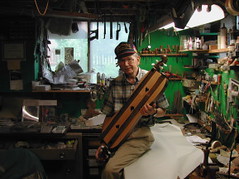Homer Ledford--6,000 dulcimers

Born September 27, 1927 at Ivyton, TN, Homer has dedicated his life to creating both music and musical instruments that brilliantly reflect his Appalachian cultural heritage. Homer has succeeded in making the traditional arts glow vibrantly at a time when the clamor of popular music-as-commodity has threatened to drown out the sweet strains of traditional indigenous music. In his humble and generous fashion, Homer has helped save a culture from extinction but, more importantly, he has passed that cultural expression on to future generations through the legacy of his extraordinary instruments, and through his musical performance.
Ledford is the very model of a traditional craftsman. He learned his trade through oral tradition and informal apprenticeship, at his community in the Tennessee hill country, at the John C. Campbell School, and at Berea College. I have heard him say in only a half-comedic way “this here’s my shop” while pointing to his ancient pocketknife. Although he uses a vast array of tools to fashion his instruments, a large percentage of the work is still accomplished with just his pocketknife and his adept carving skills. 
Homer has continued to perfect the dulcimer by ameliorating the inaccuracies of scale, increasing the dimensions of the sound box, improving the endpin construction, and polishing the style of the scroll headstock. A dulcimer constructed by Homer Ledford is recognizable as kith and kin to the earliest known Eastern Kentucky instruments, and yet a Homer Ledford dulcimer is vastly superior in tone, tuning, function, and appearance. These are instruments that will continue to live and sing for generations long after their creator is no longer with us.
Scholars have frequently puzzled over that curious uncharted region lying between tradition and innovation, between past and present, and between craft and art. Certainly, it is precisely the negotiation of these equivocal areas that makes Homer Ledford such a splendid artisan and artist. Homer has maintained the integrity of Appalachian dulcimer design in the Cumberland highlands lineage of “Uncle” Ed Thomas and Jethro Amburgy. After an astounding 5,9010 dulcimers, the classic hand-carved lines of the heart shaped sound holes, the overhanging sides, and the proportions of the hourglass body have been carefully sustained and refined.
However, Homer is also an innovative craftsman who expanded the boundaries of his traditional heritage by adopting new techniques and creating entirely new instruments. He is, simply, an Edison. Homer is always thinking, dreaming, and working out ways to make things sound better, work better, and look more interesting. He constantly seeks to improve his art and craft. In the process, he has created a series of original instruments (some of which are contained in the Smithsonian Institution’s permanent collection) such as a “dulcitar,” a “dulcijo,” and a “dulcibro” that marry complementary aspects of several different traditional instruments.
Recently, Homer completed dulcimer number 6,000--a very specially designed one that was made for Bill Johnson of Lexington KY. For more information on Homer, see the University Press of Kentucky book Dulcimer Maker: The Craft of Homer Ledford by R. Gerald Alvey.


4 Comments:
I just love that you're doing this. You are my favorite blogger!
ps: I'm trying my hand at an "aggregator," an app that kind of rolls blogs together for easy reading. Not convinced it's the thing, but it may be... I guess type "aggregator" into blogger's help section to find out more..
or here.
Are there any current [2008] Homer Ledford or dulcimer blogs? Thanks
Are there any current [2008] Homer Ledford or dulcimer blogs? Thanks
My challenge to readers and folks who may have the HL dulcimers... He posted a number in each dulcimer. If you have a dulcimer from HL, post your number. Maybe, all his can be found... Rebeccajo from WA State
Post a Comment
<< Home